Team Losi Micro-T: A crazydave review
Posted: Sun Dec 10, 2006 9:10 pm
Team Losi Micro-T (LOSB0230) $79.99
Specs:
Scale: 1/36
Length: 4.5 in (114mm)
Width: 3.5 in (89mm)
Wheelbase: 3 in (76mm)
Weight: 3.4 oz (96g)
Overview
Click on thumbnails to view full size version
1a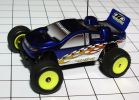 1b
1b 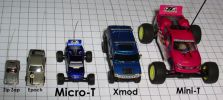 1c
1c  1d
1d 
With the Micro-T (fig.1a) Team Losi has created a whole new scale. At 1/36th, it is 4.5 inches long, and slightly longer than an Epoch, while still quite a bit shorter than the Xmod. (fig.1b) It is probably the smallest RC with this much sophistication.
The Losi 27mhz AM radio (fig. 1c) looks just like the one that comes with the Mini LST, but it is AM. I like the feel of this a lot better than the one that comes with the Mini-T. It might be kinda large for smaller kid hands, but it fits my hand nice, has fat soft foamy grip on the steering, and has a nice feel to the controls.
The battery operated peak charger (fig. 1d), seems to work well, and I like its portability, but the option of an AC adaptor would have been a nice addition.
It also comes with 8 Alkaline AAs for the charger, and 8 Heavy Duty AAs for the Tx. 2 pinions in smaller and larger sizes than come in the car, and a couple extra body clips are a nice inclusion. It is a complete and fun package right out of the box.
The Body
The body is an exact copy of the one used on the Mini-T. It feels to me more like cheap polycarbonate rather than Lexan, but its more than adequate at this scale. I got mine in Blue, and its a beautiful deep shade of metallic blue. They are also available in Red and Green. My only nit picky comlaint is I wish the windows were left clear rather than the stickers.
The Chassis.
2a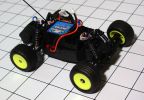 2b
2b 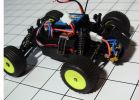 2c
2c 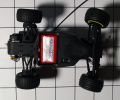
The chassis (figs. 2a & 2b) looks a bit clunky and toyish at first, but closer inspection reveals they maintained the XXT design characteristics wherever possible. The front and rears are pretty faithful, while the center section is beefed up quite a bit, due to the small size. Since the PCB and its cover are screwed to the top, battery removal is done by removing 2 screws from the bottom (fig. 2c). They also kept the modular design of the Mini-T and XXT, so its easy to remove just the front or rear ends for maintenence.
The Suspension
3a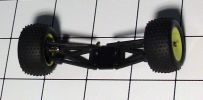 3b
3b 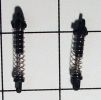 3c
3c 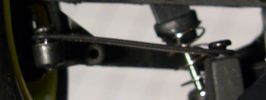
3d 3e
3e 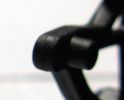 3f
3f 
The Micro-T shares its wide arm racing supesion with its older brothers as well. Here's you can see the supensions modular design with the rear end removed.(fig. 3a) The upper camber links are not adjustable, at this scale its easy to make your own in different sizes. The inside hinge pins are captured, and screws are used on the outside. The shocks (fig. 3b) are not much bigger than Xmod shocks. With this in mind, I'm not really foreseeing oil dampers. The supsension is smooth, but a tad bouncy, I'd reccomend picking up some friction damper grease, Tamiya and many other companies make this stuff in different viscosities, and it'll make friction dampers feel like oil dampers, but it make a mess to clean up.
The front suspension is similar to the back, but the steering links (fig. 3c) are thin flat pieces of plastic. Really they're ingenious because they serve the dual purpose of absorbing some impact, and also flexing when the suspension is compressed. (fig. 3d) They are also an achilles heal. The plastic is a bit too brittle for this application. I broke one on my first run, head on collision seem to do them in, but I replaced it with a homemade one, I whipped up from some plastic packaging, and haven't had a problem since.
The rear shocks have two mounting holes on the bottom, but other than that there is little adjustabilty, from the front,(fig. 3e) but look again from the back(fig. 3f), and you see they started different mounting holes. I'm sure someone could easily figure out how to drill them out, and make little spacers for the front. (Warning: I have not tried this, and it may weaken that area of the shock tower). That would give you three options on both the front and rear shock tower. Plus there are two camber positions on both the rear shock tower, and rear uprights that could be drilled out.
Drivetrain
4a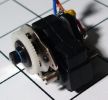 4b
4b  4c
4c 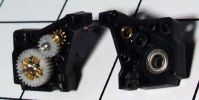 4d
4d 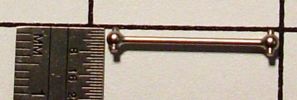
The Micro-T uses a slipper equipped 3 gear transmission (fig. 4a) similar to its older siblings. The slipper is similar to the Mini-T's, but uses two rubber O-rings (fig. 4b), probably from an 1/18th scale shock, to compress against the pressure plate. This should actually be superior to the Mini-T's bent washer approach, and offer a better range of adjustablity. One area of weakeness I can see, is the plastic nut. Seems to work well, but I've had nothing but bad experiences with plastic nuts. I used an Xmod wrench to take it off, so the outside dimesions are the same as Xmod/MiniZ wheel nuts, but I haven't confirmed the size of the hole. Maybe if somebody has an extra metal nut for their MiniZ, they could try it out.
The motor plate is a thin piece of metal, it is flexable, but well supported.
Opening up the tranny(fig. 4c), we can see the top shaft is supported by brass bushings, probably too difficult or expensive to replace with bearings. the center gear spins on a shaft with no bushings, and the differential is supported by bearings. It is fairly smooth, but not as smooth as a bearing supported tranny. I noted some resistance when I intially ran the car, but its loosened up now. The wheels have plastic bushings, and Losi offer's a wheel and hub only bearing set.
The diffs actually have some heavy duty brass gears in them, though the outdrive gears are plastic. The diff was very stiff in my car to start with, causing wide turns, but it is slowly loosening up.
It uses use little tiny metal dogbones (fig. 4d), and little metal drive cups. The dogbones don't look much thicker than a paper clip, and I think I noted a tad bit of twisting, but they work surprisingly well for thier size.
The Electronics
5a 5b
5b  5c
5c  5d
5d 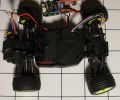 5e
5e 
The motor (fig. 5a) in the Micro-T is not of a standard size. It is 14mm across the wide part, 11mm across the narrow part, and 20mm long. People have speculated that it is the size of a N2O airplane motor, but i haven't confirmed that. It is punchy and works very good.
The battery (fig. 5a) is 4 150mah 1/3 AAAs, just like what we see in out Zip Zaps, but nicely packages in some shrink wrap, and wired with a plug.
The removal of 4 screws allows the PCB cover to come off, and reveal a PCB (fig. 5c) that uses FETs just like the ones used in Xmods/Mini-Zs.
Removing two more screws lets the PCB come off and reveal an upper deck (fig. 5d) That could easily be used to mount aftermarket electronics if you could find some small enough to fit.
Taking the cover in the front off reveals the servo. (fig. 5e) Yes it is a 5 wire servo, and it fits snugly in its place. Its dimensions are 23mmHx21mmWx12mmD.
Driving the Micro-T
Finally, the part you've been waiting for, we get to drive it. You can have it out of the box and charging in mere minutes, but I took the time to savor the moment. It should take 20-25 minutes to charge the battery, but mine kept false peaking after about 8 minutes. Even after several runs, I have to keep unplugging it and plugging it back in to get 20 minutes charge time out of it. I think I'm gonna try ordering a new battery.
From the first pull of the trigger, this thing lifts its front wheels, and snaps off, you know its gonna be good. It is very fast for its size out of the box. I couldn't really imagine it with the faster motor Losi will be offering. I tried it on a series of jumps, and it handles jumps great, as long as you don't make them too large for this tiny guy. Much more levelflight than the Mini-T, and its very responsive to throttle input in midair. Its a tad bouncy on landing, due to the friction dampers, but its not super-noticable. Its steering is a tad bit wide, but I think that is due to the tight diff. After three runs it is starting to loosen up a bit, I think once it breaks in it will be perfect. As it is now it steers fairly tight when going slow, but a little too wide at speed. The wheelie action also limits steering at speed. I loosened the slipper a tad and that seemed to help, but I think I'll loosen it some more.
Bottom line, this is a great car for romping in your living room. I don't foresee a whole lot of organized racing potential, right off the bat, but it is great for some indoor fun with your buddies. I love it, just what I've always wanted, but seeing is believing, so check out the vid I made.

The Good
-Lots of features for its size
-Fast out of the box
-Well built
-Everything included
-Handles and jumps good
-Lots of fun
The Bad
-Steering linkage tends to break
-Limited adjustablity
-Many parts too small to attract aftermarket attention
-Many non-standard parts
The Ugly
-Wheels held on by tiny e-clips
Specs:
Scale: 1/36
Length: 4.5 in (114mm)
Width: 3.5 in (89mm)
Wheelbase: 3 in (76mm)
Weight: 3.4 oz (96g)
Overview
Click on thumbnails to view full size version
1a
 1b
1b  1c
1c  1d
1d 
With the Micro-T (fig.1a) Team Losi has created a whole new scale. At 1/36th, it is 4.5 inches long, and slightly longer than an Epoch, while still quite a bit shorter than the Xmod. (fig.1b) It is probably the smallest RC with this much sophistication.
The Losi 27mhz AM radio (fig. 1c) looks just like the one that comes with the Mini LST, but it is AM. I like the feel of this a lot better than the one that comes with the Mini-T. It might be kinda large for smaller kid hands, but it fits my hand nice, has fat soft foamy grip on the steering, and has a nice feel to the controls.
The battery operated peak charger (fig. 1d), seems to work well, and I like its portability, but the option of an AC adaptor would have been a nice addition.
It also comes with 8 Alkaline AAs for the charger, and 8 Heavy Duty AAs for the Tx. 2 pinions in smaller and larger sizes than come in the car, and a couple extra body clips are a nice inclusion. It is a complete and fun package right out of the box.
The Body
The body is an exact copy of the one used on the Mini-T. It feels to me more like cheap polycarbonate rather than Lexan, but its more than adequate at this scale. I got mine in Blue, and its a beautiful deep shade of metallic blue. They are also available in Red and Green. My only nit picky comlaint is I wish the windows were left clear rather than the stickers.
The Chassis.
2a
 2b
2b  2c
2c 
The chassis (figs. 2a & 2b) looks a bit clunky and toyish at first, but closer inspection reveals they maintained the XXT design characteristics wherever possible. The front and rears are pretty faithful, while the center section is beefed up quite a bit, due to the small size. Since the PCB and its cover are screwed to the top, battery removal is done by removing 2 screws from the bottom (fig. 2c). They also kept the modular design of the Mini-T and XXT, so its easy to remove just the front or rear ends for maintenence.
The Suspension
3a
 3b
3b  3c
3c 
3d
 3e
3e  3f
3f 
The Micro-T shares its wide arm racing supesion with its older brothers as well. Here's you can see the supensions modular design with the rear end removed.(fig. 3a) The upper camber links are not adjustable, at this scale its easy to make your own in different sizes. The inside hinge pins are captured, and screws are used on the outside. The shocks (fig. 3b) are not much bigger than Xmod shocks. With this in mind, I'm not really foreseeing oil dampers. The supsension is smooth, but a tad bouncy, I'd reccomend picking up some friction damper grease, Tamiya and many other companies make this stuff in different viscosities, and it'll make friction dampers feel like oil dampers, but it make a mess to clean up.
The front suspension is similar to the back, but the steering links (fig. 3c) are thin flat pieces of plastic. Really they're ingenious because they serve the dual purpose of absorbing some impact, and also flexing when the suspension is compressed. (fig. 3d) They are also an achilles heal. The plastic is a bit too brittle for this application. I broke one on my first run, head on collision seem to do them in, but I replaced it with a homemade one, I whipped up from some plastic packaging, and haven't had a problem since.
The rear shocks have two mounting holes on the bottom, but other than that there is little adjustabilty, from the front,(fig. 3e) but look again from the back(fig. 3f), and you see they started different mounting holes. I'm sure someone could easily figure out how to drill them out, and make little spacers for the front. (Warning: I have not tried this, and it may weaken that area of the shock tower). That would give you three options on both the front and rear shock tower. Plus there are two camber positions on both the rear shock tower, and rear uprights that could be drilled out.
Drivetrain
4a
 4b
4b  4c
4c  4d
4d 
The Micro-T uses a slipper equipped 3 gear transmission (fig. 4a) similar to its older siblings. The slipper is similar to the Mini-T's, but uses two rubber O-rings (fig. 4b), probably from an 1/18th scale shock, to compress against the pressure plate. This should actually be superior to the Mini-T's bent washer approach, and offer a better range of adjustablity. One area of weakeness I can see, is the plastic nut. Seems to work well, but I've had nothing but bad experiences with plastic nuts. I used an Xmod wrench to take it off, so the outside dimesions are the same as Xmod/MiniZ wheel nuts, but I haven't confirmed the size of the hole. Maybe if somebody has an extra metal nut for their MiniZ, they could try it out.
The motor plate is a thin piece of metal, it is flexable, but well supported.
Opening up the tranny(fig. 4c), we can see the top shaft is supported by brass bushings, probably too difficult or expensive to replace with bearings. the center gear spins on a shaft with no bushings, and the differential is supported by bearings. It is fairly smooth, but not as smooth as a bearing supported tranny. I noted some resistance when I intially ran the car, but its loosened up now. The wheels have plastic bushings, and Losi offer's a wheel and hub only bearing set.
The diffs actually have some heavy duty brass gears in them, though the outdrive gears are plastic. The diff was very stiff in my car to start with, causing wide turns, but it is slowly loosening up.
It uses use little tiny metal dogbones (fig. 4d), and little metal drive cups. The dogbones don't look much thicker than a paper clip, and I think I noted a tad bit of twisting, but they work surprisingly well for thier size.
The Electronics
5a
 5b
5b  5c
5c  5d
5d  5e
5e 
The motor (fig. 5a) in the Micro-T is not of a standard size. It is 14mm across the wide part, 11mm across the narrow part, and 20mm long. People have speculated that it is the size of a N2O airplane motor, but i haven't confirmed that. It is punchy and works very good.
The battery (fig. 5a) is 4 150mah 1/3 AAAs, just like what we see in out Zip Zaps, but nicely packages in some shrink wrap, and wired with a plug.
The removal of 4 screws allows the PCB cover to come off, and reveal a PCB (fig. 5c) that uses FETs just like the ones used in Xmods/Mini-Zs.
Removing two more screws lets the PCB come off and reveal an upper deck (fig. 5d) That could easily be used to mount aftermarket electronics if you could find some small enough to fit.
Taking the cover in the front off reveals the servo. (fig. 5e) Yes it is a 5 wire servo, and it fits snugly in its place. Its dimensions are 23mmHx21mmWx12mmD.
Driving the Micro-T
Finally, the part you've been waiting for, we get to drive it. You can have it out of the box and charging in mere minutes, but I took the time to savor the moment. It should take 20-25 minutes to charge the battery, but mine kept false peaking after about 8 minutes. Even after several runs, I have to keep unplugging it and plugging it back in to get 20 minutes charge time out of it. I think I'm gonna try ordering a new battery.
From the first pull of the trigger, this thing lifts its front wheels, and snaps off, you know its gonna be good. It is very fast for its size out of the box. I couldn't really imagine it with the faster motor Losi will be offering. I tried it on a series of jumps, and it handles jumps great, as long as you don't make them too large for this tiny guy. Much more levelflight than the Mini-T, and its very responsive to throttle input in midair. Its a tad bouncy on landing, due to the friction dampers, but its not super-noticable. Its steering is a tad bit wide, but I think that is due to the tight diff. After three runs it is starting to loosen up a bit, I think once it breaks in it will be perfect. As it is now it steers fairly tight when going slow, but a little too wide at speed. The wheelie action also limits steering at speed. I loosened the slipper a tad and that seemed to help, but I think I'll loosen it some more.
Bottom line, this is a great car for romping in your living room. I don't foresee a whole lot of organized racing potential, right off the bat, but it is great for some indoor fun with your buddies. I love it, just what I've always wanted, but seeing is believing, so check out the vid I made.

The Good
-Lots of features for its size
-Fast out of the box
-Well built
-Everything included
-Handles and jumps good
-Lots of fun
The Bad
-Steering linkage tends to break
-Limited adjustablity
-Many parts too small to attract aftermarket attention
-Many non-standard parts
The Ugly
-Wheels held on by tiny e-clips